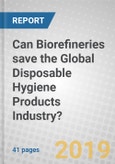Disposable absorbent hygiene products (AHPs), consisting of baby diapers, femcare products (sanitary pads, panty liners, etc.) and adult incontinence (AI) products, are big business.
Forecasts vary, but the combined global value of these markets at retail was around $90 billion in 2018. Consequently, there are very sophisticated embedded networks for the manufacture and supply of AHPs, and there is a lot of vested interest in maintaining business as usual.
It is not always recognized by consumers, however, that despite their undoubted convenience and contribution to healthy living, AHPs are currently all based on petroleum-derived plastics. They are primarily based on polypropylene (PP), polyethylene (PE) or polyester (PET) that has been converted, in combination with wood pulp, superabsorbent polymers (SAP) and elastics, into nonwoven fabrics by the spunbonding and meltblowing extrusion processes known as “spunmelt.”
Report Includes:
- An overview of the market size and structure of global disposable hygiene products market and a description of its key players
- Information on bio-derived alternatives for disposable hygiene product that already exist, or are under development
- A look at the initiatives taken for recycling of disposable hygiene products in various areas
- Evaluation of major developments and market dynamics for disposable absorbent hygiene products (AHPs)
Table of Contents
Companies Mentioned
- Avantium Technologies
- Borealis
- Braskem
- Danimer Scientific
- Fitesa
- Kimberly-Clark
- Lenzing
- Mitusi
- Natureworks
- Neste Technology
- Novamont
- Total Corbion
- Virent








